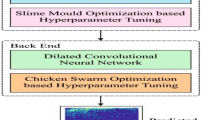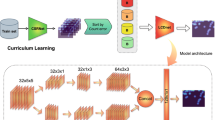Abstract
The advancements in computer vision-related technologies attract many researchers for surveillance applications, particularly involving the automated crowded scenes analysis such as crowd counting in a very congested scene. In crowd counting, the main goal is to count or estimate the number of people in a particular scene. Understanding overcrowded scenes in real-time is important for instant responsive actions. However, it is a very difficult task due to some of the key challenges including clutter background, occlusion, variations in human pose and scale, and limited surveillance training data, that are inadequately covered in the employed literature. To tackle these challenges, we introduce “SD-Net” an end-to-end CNN architecture, which produces real-time high quality density maps and effectively counts people in extremely overcrowded scenes. The proposed architecture consists of depthwise separable, standard, and dilated 2D convolutional layers. Depthwise separable and standard 2D convolutional layers are used to extract 2D features. Instead of using pooling layers, dilated 2D convolutional layers are employed that results in huge receptive fields and reduces the number of parameters. Our CNN architecture is evaluated using four publicly available crowd analysis datasets, demonstrating superiority over state-of-the-art in terms of accuracy and model size.









Similar content being viewed by others
References
Li, T., et al.: Crowded scene analysis: a survey. IEEE Trans. Circuits Syst. Video Technol. 25(3), 367–386 (2014)
Hassaballah, M., Kenk, M.A., Elhenawy, I.M.: On-road vehicles detection using appearance and texture information. Egypt. Comput. Sci. J. 43(1) (2019)
Zhang, C., et al.: Cross-scene crowd counting via deep convolutional neural networks. In: Proceedings of the IEEE conference on computer vision and pattern recognition (2015)
Zhang, C., et al.: Data-driven crowd understanding: a baseline for a large-scale crowd dataset. IEEE Trans. Multimedia 18(6), 1048–1061 (2016)
Li, Y., Zhang, X., Chen, D.: Csrnet: Dilated convolutional neural networks for understanding the highly congested scenes. In: Proceedings of the IEEE conference on computer vision and pattern recognition (2018)
Pan, J., et al.: Shallow and deep convolutional networks for saliency prediction. In: Proceedings of the IEEE Conference on Computer Vision and Pattern Recognition (2016)
Long, J., Shelhamer, E., Darrell, T.: Fully convolutional networks for semantic segmentation. In: Proceedings of the IEEE conference on computer vision and pattern recognition (2015)
Wei, Y., et al.: Stc: A simple to complex framework for weakly-supervised semantic segmentation. IEEE Trans. Pattern Anal. Mach. Intell. 39(11), 2314–2320 (2016)
Wei, Y., et al.: Object region mining with adversarial erasing: a simple classification to semantic segmentation approach. In: Proceedings of the IEEE conference on computer vision and pattern recognition (2017)
Yu, F., Koltun, V.: Multi-scale context aggregation by dilated convolutions. ar**v preprint ar**v:1511.07122 (2015)
Chen, L.-C., et al.: Deeplab: semantic image segmentation with deep convolutional nets, atrous convolution, and fully connected crfs. IEEE Trans. Pattern Anal. Mach. Intell. 40(4), 834–848 (2017)
Andri, R., et al.: YodaNN: An ultra-low power convolutional neural network accelerator based on binary weights. In: 2016 IEEE Computer Society Annual Symposium on VLSI (ISVLSI). 2016. IEEE
Jia, Y., et al.: Caffe: Convolutional architecture for fast feature embedding. In: Proceedings of the 22nd ACM international conference on Multimedia (2014)
Qiu, J., et al.: Going deeper with embedded fpga platform for convolutional neural network. In: Proceedings of the 2016 ACM/SIGDA International Symposium on Field-Programmable Gate Arrays (2016)
Zhang, X., et al.: High-performance video content recognition with long-term recurrent convolutional network for FPGA. In: 2017 27th International Conference on Field Programmable Logic and Applications (FPL). 2017. IEEE
Zhang, X., et al.: Machine learning on FPGAs to face the IoT revolution. In: 2017 IEEE/ACM International Conference on Computer-Aided Design (ICCAD). 2017. IEEE
Loy, C.C., et al.: Crowd counting and profiling: Methodology and evaluation. Modeling, simulation and visual analysis of crowds, pp. 347–382. Springer, Berlin (2013)
Dollar, P., et al.: Pedestrian detection: an evaluation of the state of the art. IEEE Trans. Pattern Anal. Mach. Intell. 34(4), 743–761 (2011)
Dalal, N., Triggs, B.: Histograms of oriented gradients for human detection. In: 2005 IEEE computer society conference on computer vision and pattern recognition (CVPR'05). 2005. IEEE.
Viola, P., Jones, M.J.: Robust real-time face detection. Int. J. Comput. Vision 57(2), 137–154 (2004)
Felzenszwalb, P.F., et al.: Object detection with discriminatively trained part-based models. IEEE Trans. Pattern Anal. Mach. Intell. 32(9), 1627–1645 (2009)
Hassaballah, M., Awad, A.I.: Detection and description of image features: an introduction. Image feature detectors and descriptors, pp. 1–8. Springer, Berlin (2016)
Chan, A.B., Vasconcelos, N.: Bayesian Poisson regression for crowd counting. In: 2009 IEEE 12th international conference on computer vision. 2009. IEEE.
Idrees, H., et al.: Multi-source multi-scale counting in extremely dense crowd images. In: Proceedings of the IEEE conference on computer vision and pattern recognition (2013)
Lowe, D.G.: Object recognition from local scale-invariant features. In: Proceedings of the seventh IEEE international conference on computer vision. 1999. IEEE.
Lempitsky, V., Zisserman, A.: Learning to count objects in images. In: Advances in neural information processing systems (2010)
Pham, V.-Q., et al.: Count forest: Co-voting uncertain number of targets using random forest for crowd density estimation. In: Proceedings of the IEEE International Conference on Computer Vision (2015)
Hassaballah, M., Awad, A.I.: Deep learning in computer vision: principles and applications. CRC Press, Boca Raton (2020)
Muhammad, K., et al.: Energy-efficient monitoring of fire scenes for intelligent networks. IEEE Netw. 34(3), 108–115 (2020)
Ullah, A., et al.: Action recognition using optimized deep autoencoder and CNN for surveillance data streams of non-stationary environments. Future Gener. Comput. Syst. 96, 386–397 (2019)
Krizhevsky, A., Sutskever, I., Hinton, G.E.: Imagenet classification with deep convolutional neural networks. In: Advances in neural information processing systems (2012)
Simonyan, K., Zisserman, A.: Very deep convolutional networks for large-scale image recognition. ar**v preprint ar**v:1409.1556 (2014)
Yan, L., Zheng, Y., Cao, J.: Few-shot learning for short text classification. Multimedia Tools Appl. 77(22), 29799–29810 (2018)
Hassaballah, M., Hosny, K.M.: Recent advances in computer vision: theories and applications, vol. 804. Springer, Berlin (2018)
Ul Haq, I., et al.: Personalized movie summarization using deep cnn-assisted facial expression recognition. Complexity. 2019 (2019)
Muhammad, K., et al.: Deep learning for Multigrade Brain Tumor classification in smart healthcare systems: a prospective survey. IEEE Trans. Neural Netw. Learn. Syst. (2020)
Ullah, F.U.M., et al.: Violence detection using spatiotemporal features with 3D convolutional neural network. Sensors 19(11), 2472 (2019)
Khan, S.U., et al.: Cover the violence: a novel deep-learning-based approach towards violence-detection in movies. Appl. Sci. 9(22), 4963 (2019)
Walach, E., Wolf, L.: Learning to count with cnn boosting. In: European conference on computer vision. Springer, Berlin (2016)
Shang, C., Ai, H., Bai, B.: End-to-end crowd counting via joint learning local and global count. In: 2016 IEEE International Conference on Image Processing (ICIP). 2016. IEEE
Boominathan, L., Kruthiventi, S.S., Babu, R.V.: Crowdnet: A deep convolutional network for dense crowd counting. In: Proceedings of the 24th ACM international conference on Multimedia (2016)
Marsden, M., et al.: Fully convolutional crowd counting on highly congested scenes. ar**v preprint ar**v:1612.00220 (2016)
Sindagi, V.A., Patel, V.M.: Cnn-based cascaded multi-task learning of high-level prior and density estimation for crowd counting. In: 2017 14th IEEE International Conference on Advanced Video and Signal Based Surveillance (AVSS). 2017. IEEE.
Zhang, Y., et al.: Single-image crowd counting via multi-column convolutional neural network. In: Proceedings of the IEEE conference on computer vision and pattern recognition (2016)
Onoro-Rubio, D., López-Sastre, R.J.: Towards perspective-free object counting with deep learning. In: European Conference on Computer Vision. Springer, Berlin (2016)
Shi, X., et al.: A real-time deep network for crowd counting. ar**v preprint ar**v:2002.06515, (2020)
Wang, N., et al.: A light tracker for online multiple pedestrian tracking. J. Real-Time Image Process. 1–17
Balasundaram, A., Chellappan, C.: An intelligent video analytics model for abnormal event detection in online surveillance video. J. Real-Time Image Process. 1–16 (2018)
Shallari, I., Krug, S., O’Nils, M.: Communication and computation inter-effects in people counting using intelligence partitioning. J. Real-Time Image Process. 1–14 (2020)
Migniot, C., Ababsa, F.: Hybrid 3D–2D human tracking in a top view. J. Real-Time Image Proc. 11(4), 769–784 (2016)
Poiesi, F., Cavallaro, A.: Predicting and recognizing human interactions in public spaces. J. Real-Time Image Proc. 10(4), 785–803 (2015)
Nam, Y., Hong, S.: Real-time abnormal situation detection based on particle advection in crowded scenes. J. Real-Time Image Proc. 10(4), 771–784 (2015)
Bahri, H., et al.: Real-time moving human detection using HOG and Fourier descriptor based on CUDA implementation. J. Real-Time Image Process. 1–16 (2019)
Chun, S., Lee, C.-S., Jang, J.-S.: Real-time smart lighting control using human motion tracking from depth camera. J. Real-Time Image Proc. 10(4), 805–820 (2015)
Lotfi, M., Motamedi, S.A., Sharifian, S.: Time-based feedback-control framework for real-time video surveillance systems with utilization control. J. Real-Time Image Proc. 16(4), 1301–1316 (2019)
Sam, D.B., Surya, S., Babu, R.V.: Switching convolutional neural network for crowd counting. In: 2017 IEEE Conference on Computer Vision and Pattern Recognition (CVPR). 2017. IEEE
Sindagi, V.A., Patel, V.M.: Generating high-quality crowd density maps using contextual pyramid cnns. In: Proceedings of the IEEE International Conference on Computer Vision (2017)
Chan, A.B., Liang, Z.-S.J., Vasconcelos, N.: Privacy preserving crowd monitoring: Counting people without people models or tracking. In: 2008 IEEE Conference on Computer Vision and Pattern Recognition. 2008. IEEE
Sajjad, M., et al.: Multi-grade brain tumor classification using deep CNN with extensive data augmentation. J. Comput. Sci. 30, 174–182 (2019)
Howard, A.G., et al.: Mobilenets: Efficient convolutional neural networks for mobile vision applications. ar**v preprint ar**v:1704.04861 (2017)
Chollet, F.: Xception: Deep learning with depthwise separable convolutions. In: Proceedings of the IEEE conference on computer vision and pattern recognition (2017)
Chen, L.-C., et al.: Rethinking atrous convolution for semantic image segmentation. ar**v preprint ar**v:1706.05587 (2017)
Zeiler, M.D., et al.: Deconvolutional networks. In: 2010 IEEE Computer Society Conference on computer vision and pattern recognition. 2010. IEEE
Noh, H., Hong, S., Han, B.: Learning deconvolution network for semantic segmentation. In: Proceedings of the IEEE international conference on computer vision (2015)
Lu, Z., et al.: The Classification of Gliomas Based on a Pyramid Dilated Convolution ResNet Model. Pattern Recogn. Lett. (2020)
Tota, K., Idrees, H.: Counting in dense crowds using deep features. In: Proc. CRCV. (2015)
Acknowledgements
This research was supported by Basic Science Research Program through the National Research Foundation of Korea (NRF) funded by the Ministry of Education (No. 2019R1A2B5B01070067).
Author information
Authors and Affiliations
Corresponding author
Additional information
Publisher's Note
Springer Nature remains neutral with regard to jurisdictional claims in published maps and institutional affiliations.
Rights and permissions
About this article
Cite this article
Khan, N., Ullah, A., Haq, I.U. et al. SD-Net: Understanding overcrowded scenes in real-time via an efficient dilated convolutional neural network. J Real-Time Image Proc 18, 1729–1743 (2021). https://doi.org/10.1007/s11554-020-01020-8
Received:
Accepted:
Published:
Issue Date:
DOI: https://doi.org/10.1007/s11554-020-01020-8




